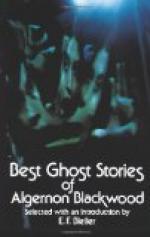“God! living God! shall I not now speak?” A dead silence followed this outcry. Nearly all had recognized this voice as that of the “silent woman.” A miracle had taken place!
“Speak! speak!” resounded the answer of the rabbi from the men’s seats below. “You may now speak!”
But no reply came. Veile had fallen back into her seat, pressing both hands against her breast. When the women sitting beside her looked at her they were terrified to find that the “silent woman” had fainted. She was dead! The unsealing of her lips was her last moment.
Long years afterwards the rabbi died. On his death-bed he told those standing about him this wonderful penance of Veile.
Every girl in the gasse knew the story of the “silent woman.”
FOOTNOTE:
[D] Copyright, 1890, by Harper Bros.
BANSHEES[E]
Of all Irish ghosts, fairies, or bogles, the Banshee (sometimes called locally the “Boh[=ee]ntha” or “Bank[=ee]ntha”) is the best known to the general public: indeed, cross-Channel visitors would class her with pigs, potatoes, and other fauna and flora of Ireland, and would expect her to make manifest her presence to them as being one of the sights of the country. She is a spirit with a lengthy pedigree—how lengthy no man can say, as its roots go back into the dim, mysterious past. The most famous Banshee of ancient times was that attached to the kingly house of O’Brien, Aibhill, who haunted the rock of Craglea above Killaloe, near the old palace of Kincora. In A.D. 1014 was fought the battle of Clontarf, from which the aged king, Brian Boru, knew that he would never come away alive, for the previous night Aibhill had appeared to him to tell him of his impending fate. The Banshee’s method of foretelling death in olden times differed from that adopted by her at the present day: now she wails and wrings her hands, as a general rule, but in the old Irish tales she is to be found washing human heads and limbs, or blood-stained clothes, till the water is all dyed with human blood—this would take place before a battle. So it would seem that in the course of centuries her attributes and characteristics have changed somewhat.
Very different descriptions are given of her personal appearance. Sometimes she is young and beautiful, sometimes old and of a fearsome appearance. One writer describes her as “a tall, thin woman with uncovered head, and long hair that floated round her shoulders, attired in something which seemed either a loose white cloak, or a sheet thrown hastily around her, uttering piercing cries.” Another person, a coachman, saw her one evening sitting on a stile in the yard; she seemed to be a very small woman, with blue eyes, long light hair, and wearing a red cloak. Other descriptions will be found in this chapter. By the way, it does not seem to be true that the Banshee exclusively follows families of Irish descent, for the last incident had reference to the death of a member of a Co. Galway family English by name and origin.




